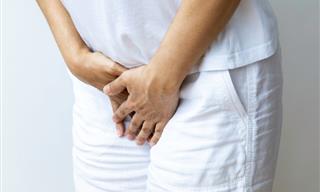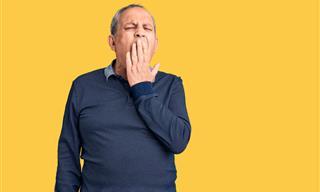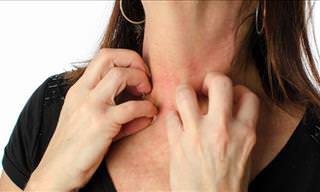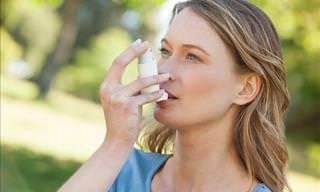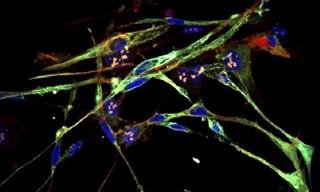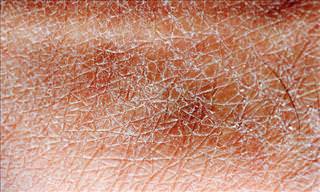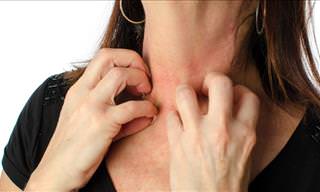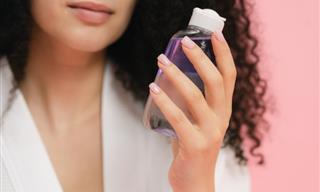
1. Yellowish skin, orange color on palms and soles
The skin hues of carotenemia are the result of an underactive thyroid gland (otherwise known as hypothyroidism), which results in increased amounts of beta-carotene in the blood. Beta-Carotene is an antioxidant found in fruits and vegetables, and is normally processed by the thyroid. If you have a thyroid problem, then the vitamins aren't metabolized as fast, and so the beta-carotene accumulates. A diet rich in carrots or carrot juice, sweet potatoes, and squash can also result in colored skin.
Additional signs: Your skin will become dry and cold. Sometimes it will seem more pale than yellowish. You may start feeling tired or weak, or experience aches throughout the body. Along with a sudden weight gain, these are the main symptoms to look out for. Women over 50 are especially at risk.
Treatment: Carotenemia is caused by bad nutrition and can be solved when a wider variety of food is consumed. However, an underactive thyroid gland is a much more serious medical condition that may lead to complications, and so we advise seeking a consultation with a physician.
2. Breaking out in hives when exposed to the sun
Don't worry, you've probably not become allergic to the sun, which is quite a rare condition. The most likely explanation of getting a rash like hives or eczema after being exposed to the sun is that you probably took a photosensitizing drug beforehand. There is a chemical in certain medications that increases our sensitivity to light.
Additional signs: The rash will be limited to the sun exposed areas of your skin - forearms, neck and the face. It can feel worse and last longer than a regular sunburn. Having darker skin won't protect you from this reaction to the medication.
One the most common drugs to do this is thiazide diuretics like Hydrodiuril or Dyazide, which are given as treatment for hypertension. Other drugs may include antihistamines, tetracycline, tretinoin (anti-aging), and certain antidepressants (tricyclic). Some people don't react to the drug this way, while others do get the rash.
Treatment: First off, check the labels on your medication. You'll be looking for sentences such as "May cause chemical photosensitivity." Second, use a high SPF sunblock, but that is not 100% assured to stop the rash. The best course of action is to cover yourself up and limit sun exposure. You can also consult your doctor about switching to a medication that doesn't include this particular side-effect.
3. Red lines on your palm
A dark coloring of the pigments in the creases of the palms or soles is a symptom of an endocrine disorder also known as Addison's disease, as it was discovered by the physician Thomas Addison. Its most famous victim was U.S. President John F. Kennedy.
Additional signs: Hyperpigmentation may also be visible around other parts of the skin, such as skin folds, lips, scars, and certain pressure points in the knees and knuckles. Another sign is low blood pressure, which can fall further when the person stands. It is most commonly found among people between the ages of 30 and 50, men and women equally.
Treatment: Skin changes such as these may be a warning sign before a serious attack, that may come as pain, vomiting, dehydration, and loss of consciousness). If you notice these symptoms mention them immediately to a doctor. A lab test to measure your cortisol (produced by the adrenal gland) will provide a diagnosis of your condition.
4. Blue leg veins
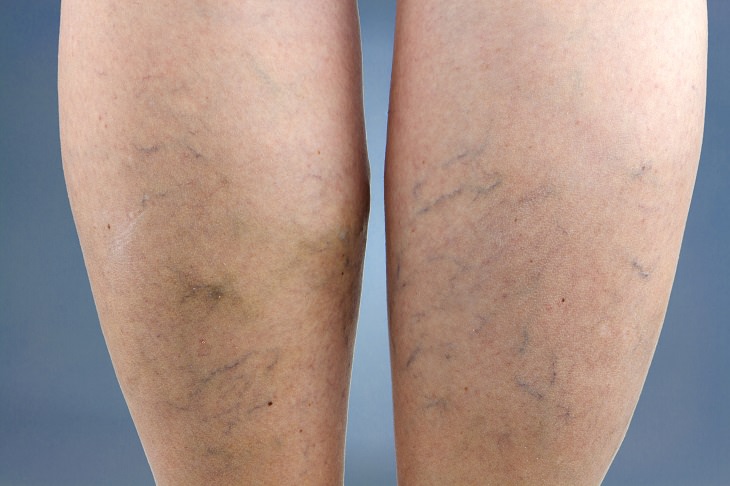
If you find your veins are suddenly these ropy, bluish-purplish lines snaking down your legs, then it may be a sign that some of them are no longer working properly. Venous disease, better known as varicose veins, can mean a mild cosmetic defect or it can mean pain, cramping, and trouble walking. Veins, not unlike one-way shutters, use valves to transfer blood and keep it circulating. If they get to a point when they don't work anymore, the blood can leak into the vein and pool there.
Additional Signs: Varicose veins may be mistaken for another vein disease, known as spider veins, which creates a web-like pattern of smaller blue or red veins. You'll notice the difference because varicose veins are larger, darker in color and are sometimes raised. They will at times look twisted. It's a very common condition. In fact, half the population of people over 50 suffer from some form of varicose veins. Women are especially affected, and the first signs of them may appear during pregnancy.
Treatment: The best treatment you can start yourself is exercising, wearing special compression stockings, and avoiding certain postures that constrict your veins, such as crossing your legs when sitting. However, these will only deal with the discomfort of varicose veins, and will not make them go away. Not all varicose veins cause health issues, but if your veins cause you any pain or become warm or tender to the touch - tell your doctor immediately.
Veins that are deeply damaged can cause dangerous blood clots that may endanger you. Medical treatment options include surgery and sclerotherapy, which is injecting a special solution into the vein to shut it down.
5. Brown spots on your legs
We tend to bang the front of our legs along the shins as we walk, without even noticing it. However, if someone is suffering from diabetes, it damages the capillaries and small blood vessels and, when these receive physical damage, they may leak, leading to the brown spots also known as diabetic demopathy.
Additional signs: Feel the brown patches. They may be rough to the touch, almost scaly, and are usually seen in circle or oval shapes. They shouldn't hurt.
Another skin change that may indicate a person is a diabetic is an unhealed sore on the foot. Diabetics slowly lose the feeling of heat, cold, touch, and pain in their feet, so they may not notice blisters or sores that may have become infected.
Treatment: If the person showing the signs is a known diabetic, then these brown spots are nothing to worry about and do not lead to anything. However, if the person has not yet been diagnosed as a diabetic, then other symptoms should be checked, such as excessive urination, thirst, blurry vision, weight loss, etc.
6. Purple splotches on your skin
If you have a bruise that doesn't seem to go away, there may be blood vessels leaking under your skin. This may be caused by several things, from a bleeding disorder to scurvy (a vitamin C deficiency). However, in those over the age of 65, who see this symptom often, it usually means the skin has been made thin and fragile by years of exposure to sun, which damages and weakens blood vessels. The condition is named senile purpura.
It's important to note that excessive use of aspirin, nonsteroidal anti-inflammatories, vitamin E, and a number of other medications older adults may take to boost their memory, can actually worsen the problem. Blood thinners such as alcohol or steroids can have the same effect.
Additional signs:
A classic bruise tends to turn black and blue following an injury. With purpura, in contrast, there doesn't need to be any trauma; the discoloration starts as red and turns purple, persisting longer than a bruise before fading or remaining brownish. The purple skin doesn't blanch (fade or lose color) when you press it. Purpura can cover large patches of skin or show up as small purple speckles called petechiae. No matter what the size, the purple areas are most common on the forearms, legs, and backs of the hands.
Treatment: Extensive or persistent bruises should always be evaluated by a doctor, as should someone who seems to bruise easily. It's important to rule out underlying causes such as a bleeding disorder.
7. A burning, itchy rash you can't get rid of

If you have small clusters of itchy blisters that seem to show up on your forearms near the elbows, knees, buttocks, back, face or scalp, you may suffer from dermatitis herpetiformis, which is a sign of celiac disease - an allergy to gluten. About 1 in 4 patients with celiac disease display these blisters.
Additional signs: The blisters will appear on both sides of your body, and the itching and burning sensation will be very intense, to the point where you can't stop scratching it.
These blisters are most common on those between the ages of 30 and 40, and most commonly in people of northern European decent.
Treatment: Report the blisters to your doctor or a dermatologist to take a blood test and a biopsy of the small intestine, which allows to detect dermatitis herpetiformis. Usually, a gluten-free diet for the rest of your life is what it takes to avoid further symptoms. The blisters may be treated with certain medications.
8. Itchiness without rash
Feeling itchy is a common occurrence, even without mosquito bites. But when it is persistent and there is no change on the skin (no bites, no rash), it may be pruritis, which is one of the earlier signs of lymphoma, a type of cancer in the lymph system. As the two types of lymphoma are Hodgkin's disease and non-Hodgkin's lymphoma, the itchiness is known as "the Hodgkin itch").
Additional signs: The level of itchiness should be more intense than that caused by dry skin. It is most commonly felt in the lower legs. More rarely, the skin may look reddish and inflamed.
Another early symptom of lymphoma is the swelling of the lymph nodes in the armpit, collarbone, neck or groin. However, there are other reasons lymph nodes may be swollen, like an infection.
Treatment: If the itchiness does not go away, consult with your doctor and get tested to rule out possible conditions.
9. Very pale skin and blue-tinged nails
Severe anemia may be indicated by the skin turning paler than usual on the face and on the palms. Anemia can be caused by a lack of iron in the blood, an ulcer, bowel diseases, among other causes. Iron-deficiency is not uncommon among adults over the age of 70, who may no longer prepare nutritious meals for themselves or have stopped due to other medical issues.
Additional signs: Regular paleness only affects the skin, but anemia also affects the red tissues in our mouths, lips, and gums. These may turn a paler version of their usual color. Other symptoms that come with anemia are tiring easily, getting headaches, suffering dizziness, and shortness of breath.
Treatment: Today it is quite easy to get over-the-counter iron supplements. Most cases of anemia can be treated with the introduction of iron into the bloodstream. Other than supplements, it's advised to eat iron-rich foods (such as egg yolks, dried fruit, red meat, leafy green vegetables, liver, among others), combined with vitamin C, which helps the iron get absorbed. You may want to consult a nutritionist or doctor to decide on a proper diet for your iron deficiency.
10. Tingling and rash
There is a painful condition known as the herpes zoster, but better known as shingles. It is transmitted by the same virus that gives people chicken pox. People who have had chicken pox usually overcome it, and the virus retreats to our sensory nerves. It usually doesn't appear again, but certain conditions, such as stress, infection, certain drugs, or a problematic immune system may cause the virus to reactivate years and decades later.
Additional signs: The rash is often preceded by a burning sensation on the skin and sensitivity to touch. Sometimes appearing days or weeks beforehand. Some experience it as mild pain. The rash will look like little red bumps, not unlike chicken pox itself, raised from the skin and appearing on the legs, face and neck (sometimes the trunk). It will only appear on one side, left or right. It will stay for a few days, then turn into pustules filled with fluid, which, if not touched, will crust over about a week to 10 days later.
Treatment: As soon as you feel this pain, you should go see a doctor. The first 72 hours allows for an antiviral medication that can significantly reduce the severity of shingles and lower your risk of developing a further complication called postherpetic neuralgia. This condition may cause the terrible pain of shingles to continue for weeks, months, or even years. This can happen to any age group, but is more common in people over 70.
Another good idea is to ask your doctor about the shingles vaccine, which is recommended for all adults over the age of 60.
 Go to BabaMail
Go to BabaMail










